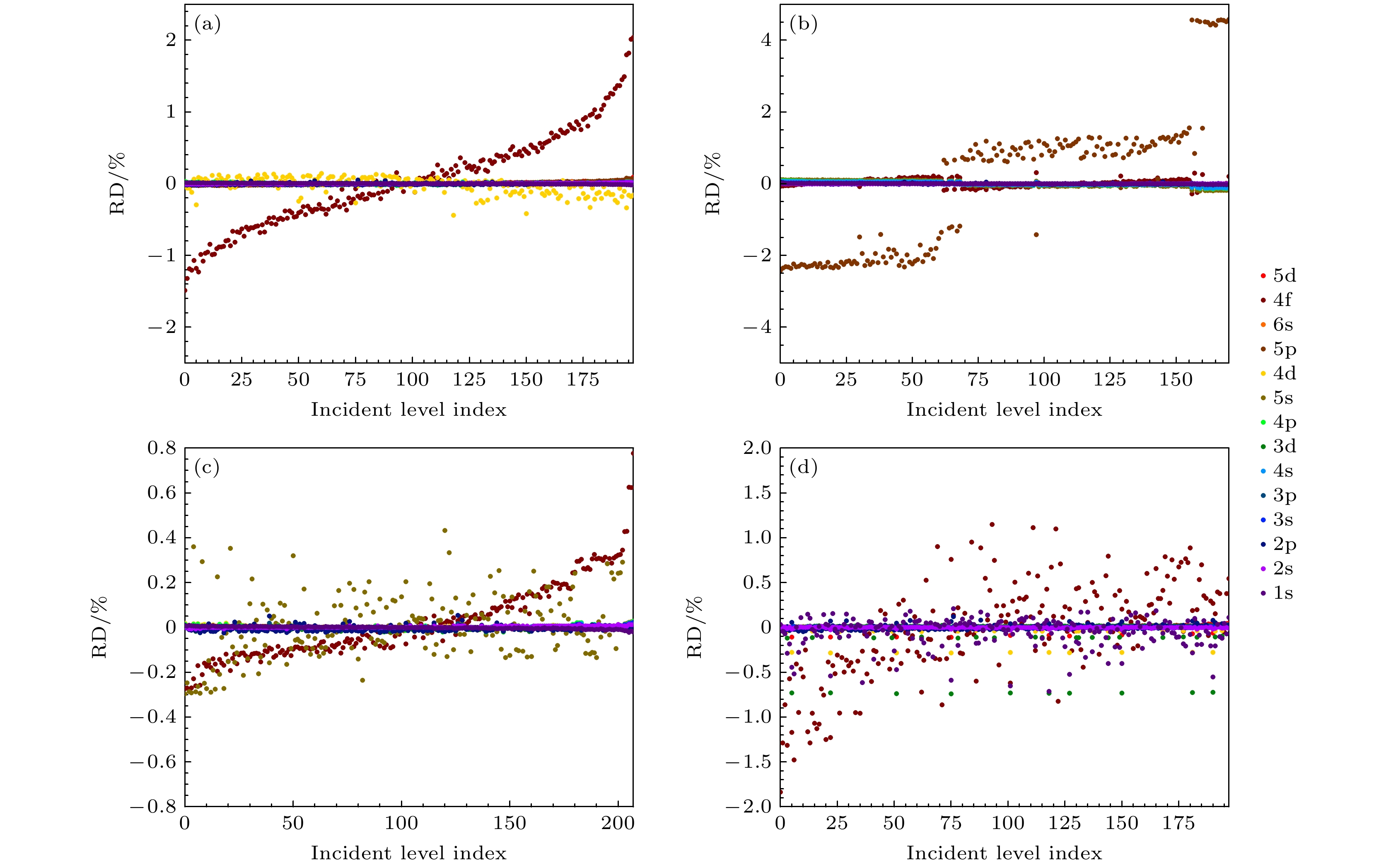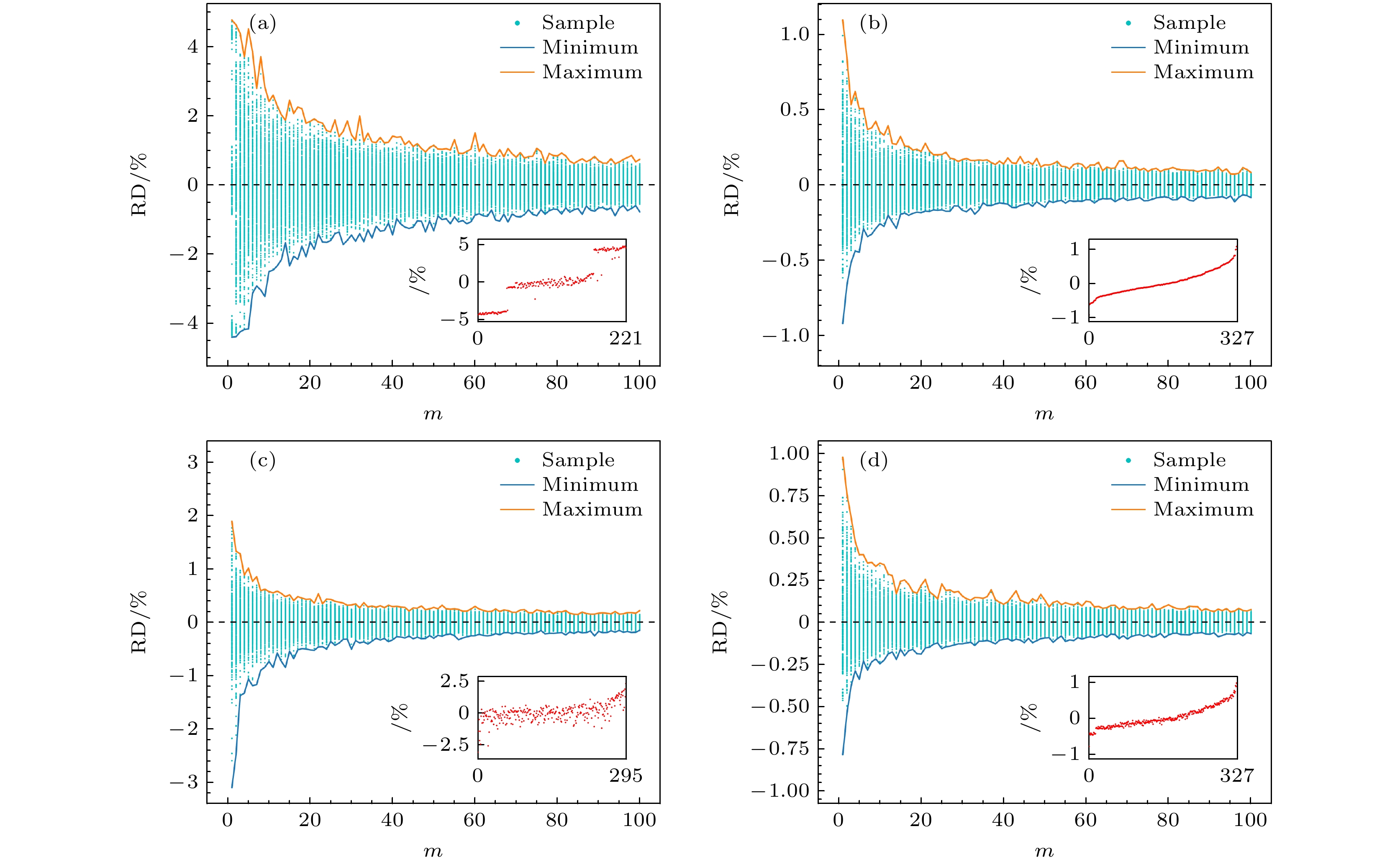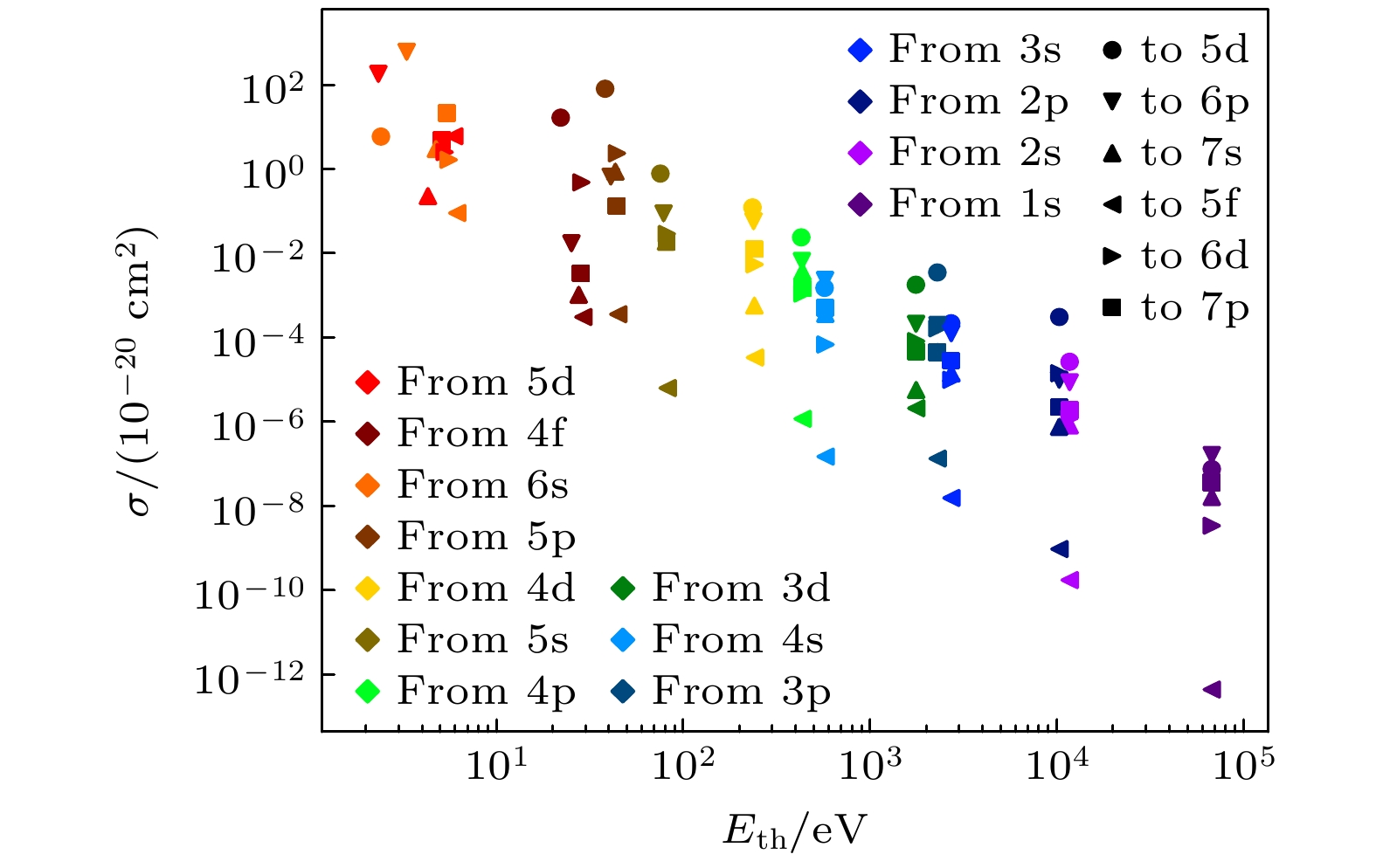-
The atomic data of medium- and high-Z elements, such as electron-impact ionization and excitation cross-sections, possess extensive applications in fields such as fusion science and X-ray interactions with matter. There are atoms and ions in high energy density plasma, with different charge states and energy states ranging from ground states to highly excited states, and the cross-sections of each charge state and energy state need to be calculated. The bottlenecks limiting computational performance are the inevitable relativistic effects of medium- and high-Z elements and the extremely complex electronic configurations. Taking tantalum (Ta) for example, by using the relativistic Dirac-Fock theory and distorted wave model, we compute the electron-impact ionization and excitation cross-sections of Ta from the ground state atom up to Ta72+ with the incident electron energy range of 1–150 keV. The detailed configuration accounting (DCA) reaction channel cross-sections are derived by summing and weighting the original detailed level accounting (DLA) cross-sections. After examining the data, two regularities are found. In terms of DLA, the pre-averaging DCA cross-sections have varying initial DLA energy levels but are typically close to each other. There is not a straightforward function that can explain the discrepancies between them. In terms of DCA, inner subshells typically contribute very little to the total cross-section as their ionization and excitation cross-sections are orders of magnitude smaller than those of outer subshells. We provide two techniques to reduce the computational costs based on the regularities. To minimize the total number of DLA reaction channels used in the computation, the initial DLA energy levels can be randomly sampled. Through a Monte Carlo numerical experiment, we determine the appropriate number of sampling points that can reduce the total number of DLA channels by an order of magnitude while maintaining a 5% error margin. In terms of impact ionization, since small cross-section DCA channels are insignificant, only a tiny portion of the DCA channels are required to preserve a 95% accuracy of the entire cross-section. It is possible to use the analytical Binary Encounter Bethe (BEB) formula to determine which DCA channels should be neglected before the computation to reduce computational costs. In terms of electron-impact excitation, just the cross-sections of the same excited subshells as the preserved ionized subshells, which are determined in the previous electron-impact ionization (EII) calculations, are needed. Finally, we compare our EII results with theoretical and experimental results. In the low incident electron energy range of below 2 keV, our results accord with the theoretical result of the 6s EII cross-section of the Ta atom and the experimental result of the total EII cross-section of the Ta1+ ion. In the high energy range of below 150 keV, our results are also consistent with the theoretical result of the 1s EII cross-section of the Ta atom and the experimental result of the 1s EII cross-section of the Cu atom. Our results reasonably match the previous experimental and theoretical results in low-energy range and high-energy range, inner subshell and outer subshell, indicating the accuracy of our calculation. The proposed optimizing strategy can be applied to various medium- to high-Z elements and is compatible to most computation codes.
-
Keywords:
- electron-impact ionization /
- electron-impact excitation /
- distorted wave model /
- atomic data
[1] Ackermann W, Asova G, Ayvazyan V, et al. 2007 Nat. Photon. 1 336
 Google Scholar
Google Scholar
[2] Emma P, Akre R, Arthur J, et al. 2010 Nat. Photon. 4 641
 Google Scholar
Google Scholar
[3] Ishikawa T, Aoyagi H, Asaka T, et al. 2012 Nat. Photon. 6 540
 Google Scholar
Google Scholar
[4] 贾豪彦, 黄森林, 焦毅等 2022 强激光与粒子束 34 05401
Jia H Y, Huang S L, Jiao Y, et al. 2022 High Power Laser Part. Beam 34 05401
[5] Zhao Z T, Wang D, Gu Q, et al. 2017 Synchrotron Radiat. News 30 6
 Google Scholar
Google Scholar
[6] 杜靖元 2009 硕士学位论文 (武汉: 华中科技大学)
Du J Y 2019 M. S. Thesis (Wuhan: Huazhong University of Science and Technology
[7] 马小云, 董晨钟, 武中文, 蒋军, 颉录有 2012 物理学报 61 213401
 Google Scholar
Google Scholar
Ma X Y, Dong C Z, Wu Z W, Jiang J, Jie L Y 2012 Acta Phys. Sin. 61 213401
 Google Scholar
Google Scholar
[8] Jurek Z, Son S K, Ziaja B, Santra R 2016 J. Appl. Cryst. 49 1048
 Google Scholar
Google Scholar
[9] Son S K, Young L, Santra R 2011 Phys. Rev. A 83 033402
 Google Scholar
Google Scholar
[10] Medvedev N, Tkachenko V, Lipp V, Li Z, Ziaja B 2018 4open 1 3
 Google Scholar
Google Scholar
[11] Renner O, Rosmej F B 2019 Matter Radiat. Extremes 4 024201
 Google Scholar
Google Scholar
[12] Barber J L, Barnes C W, Sandberg R L, Sheffield R L 2014 Phys. Rev. B 89 184105
 Google Scholar
Google Scholar
[13] Parpia F A, Fischer C F, Grant I P 1996 Comput. Phys. Commun. 94 249
 Google Scholar
Google Scholar
[14] Jönsson P, He X, Fischer C F, Grant I P 2007 Comput. Phys. Commun. 177 597
 Google Scholar
Google Scholar
[15] Gu M F 2008 Can. J. Phys. 86 675
 Google Scholar
Google Scholar
[16] Chen Z B, Tian Y S, Sang C C, Wan X L, Wang K, Guo X L 2019 Atomic Data Nucl. Data Tables 129-130 101278
 Google Scholar
Google Scholar
[17] Fritzsche S 2012 Comput. Phys. Commun. 183 1525
 Google Scholar
Google Scholar
[18] 焦飞, 蒋军, 颉录有, 张登红, 董晨钟, 陈展斌 2015 物理学报 64 233401
 Google Scholar
Google Scholar
Jiao F, Jiang J, Jie L Y, Zhang D H, Dong C Z, Chen Z B 2015 Acta Phys. Sin. 64 233401
 Google Scholar
Google Scholar
[19] Althiyabi A, El-Sayed F 2022 Atomic Data Nucl. Data Tables 147 101528
 Google Scholar
Google Scholar
[20] Zhong J Y, Zhang J, Zeng J L, Zhao G, Gu M F 2005 Atomic Data Nucl. Data Tables 89 101
 Google Scholar
Google Scholar
[21] Motoumba E B, Yoca S E, Quinet P, Palmeri P 2020 Atomic Data Nucl. Data Tables 133-134 101340
 Google Scholar
Google Scholar
[22] Aggarwal K M 2019 Atomic Data Nucl. Data Tables 125 261
 Google Scholar
Google Scholar
[23] Jönsson P, Alkauskas A, Gaigalas G 2013 Atomic Data Nucl. Data Tables 99 431
 Google Scholar
Google Scholar
[24] Wang C, Liang Y H, Hu R H, He K, Gao G L, Yan X, Yao D, Wang T, Li X Y, Tian J S, Zhu W J, Lü M 2023 arXiv: 2306.08948v1 [physics. optics]
[25] Henderson J R, Beiersdorfer P, Bennett C L 1990 Phys. Rev. Lett. 65 705
 Google Scholar
Google Scholar
[26] Knapp D A, Marrs R E, Elliott S R, Magee E W, Zasadzinski R 1993 Nucl. Instr. Meth. Phys. Res. A 334 305
 Google Scholar
Google Scholar
[27] Clementson J, Beiersdorfer P, Gu M F 2010 Phys. Rev. A 81 012505
 Google Scholar
Google Scholar
[28] Ralchenko Y, Draganic I N, Tan J N, Gillaspy J D, Pomeroy J M, Reader J, Feldman U, Holland G E 2008 J. Phys. B: At. Mol. Opt. Phys. 41 021003
 Google Scholar
Google Scholar
[29] Middleman I M, Ford H I, Hofstadter R 1970 Phys. Rev. A 2 1429
 Google Scholar
Google Scholar
[30] Müller A, Schippers S, Hellhund J, Holste K, Kilcoyne A L D, Phaneuf R A, Ballance C P, McLaughlin B M 2015 J. Phys. B: At. Mol. Opt. Phys. 48 235203
 Google Scholar
Google Scholar
[31] Santoni A, Derossi A, Finetti P, Agostino R G, Luo B 1992 Phys. Rev. B 46 15660
 Google Scholar
Google Scholar
[32] Singh N, Mittal R, Singh B, Allawadhi K L, Sood B S 1986 Phys. Rev. A 34 3459
 Google Scholar
Google Scholar
[33] Kim Y K, Rudd M E 1994 Phys. Rev. A 50 3954
 Google Scholar
Google Scholar
[34] Hübner H, Ilgen K, Hoffmann K W 1972 Z Physik. 255 269
 Google Scholar
Google Scholar
[35] Shima K 1980 Phys. Lett. A 77 237
 Google Scholar
Google Scholar
[36] Shima K, Nakagawa T, Umetani K, Mikumo T 1980 Phys. Rev. A 24 72
 Google Scholar
Google Scholar
[37] Patory M A R, Uddin M A, Haque A K F, Shahjahan M, Basak A K, Talukder M R, Saha B C 2009 Int. J. Quantum Chem. 109 897
 Google Scholar
Google Scholar
[38] Pindzola M S, Loch S D, Colgan J P 2022 J. Phys. B: At. Mol. Opt. Phys. 55 235203
 Google Scholar
Google Scholar
[39] Man K F, Smith A C H, Harrison M F A 1987 J. Phys. B: At. Mol. Phys 20 4895
 Google Scholar
Google Scholar
[40] Llovet X, Powell C J, Salvat F, Jablonski A 2014 J. Phys. Chem. Ref. Data 43 013102
 Google Scholar
Google Scholar
-
图 1 中间总截面相对于其均值的偏差 (a) Ta4+[Xe]6s04f55d10碰撞电离截面; (b) Ta9+[Kr]5s24d105p46s04f12碰撞电离截面; (c) Ta16+[Kr]5s14d105p06s04f10碰撞电离截面; (d) Ta4+[Xe]6s04f55d10碰撞激发截面, 激发到6p亚层
Figure 1. Deviation between pre-averaging total cross-section and averaged total cross-section: (a) Electron-impact ionization (EII) cross-section of Ta4+[Xe]6s04f55d10; (b) EII cross-section of Ta9+[Kr]5s24d105p46s04f12; (c) EII cross-section of Ta16+[Kr]5s14d105p06s04f10; (d) EIE cross-section of Ta4+[Xe]6s04f55d10, excited to 6p subshell.
图 2 通过蒙特卡罗实验评估采样点个数的最佳选择(碰撞电离) (a) Ta10+[Kr]5s24d105p36s04f12, 5p亚层; (b) Ta12+[Xe]6s04f7, 4f亚层; (c) Ta15+[Kr]5s04d105p66s04f6, 4f亚层; (d) Ta20+[Kr]5s04d105p06s04f7, 4f亚层
Figure 2. Evaluation of optimal number of sample points via Monte-Carlo experiment (EII): (a) Ta10+[Kr]5s24d105p36s04f12, on 5p; (b) Ta12+[Xe]6s04f7, on 4f; (c) Ta15+[Kr]5s04d105p66s04f6, on 4f; (d) Ta20+[Kr]5s04d105p06s04f7, on 4f.
图 6 基于DW方法计算的碰撞电离截面与实验和理论结果比较 (a) Ta原子的1s亚层碰撞电离截面; (b) Cu原子的1s亚层碰撞电离截面; (c) Ta原子的6s亚层碰撞电离截面; (d) Ta1+离子的总碰撞电离截面及贡献最大的几个电子亚层的碰撞电离截面(5d, 4f, 6s, 5p)
Figure 6. EII cross-sections based on DW method compared to experimental and theoretical results: (a) EII cross-section of 1s shell of Ta atom; (b) EII cross-section of 1s shell of Cu atom; (c) EII cross-section of 6s shell of Ta atom; (d) total EII cross-section of Ta1+ ion, alongside with EII cross-section of the most-contributing subshells (5d, 4f, 6s, 5p).
-
[1] Ackermann W, Asova G, Ayvazyan V, et al. 2007 Nat. Photon. 1 336
 Google Scholar
Google Scholar
[2] Emma P, Akre R, Arthur J, et al. 2010 Nat. Photon. 4 641
 Google Scholar
Google Scholar
[3] Ishikawa T, Aoyagi H, Asaka T, et al. 2012 Nat. Photon. 6 540
 Google Scholar
Google Scholar
[4] 贾豪彦, 黄森林, 焦毅等 2022 强激光与粒子束 34 05401
Jia H Y, Huang S L, Jiao Y, et al. 2022 High Power Laser Part. Beam 34 05401
[5] Zhao Z T, Wang D, Gu Q, et al. 2017 Synchrotron Radiat. News 30 6
 Google Scholar
Google Scholar
[6] 杜靖元 2009 硕士学位论文 (武汉: 华中科技大学)
Du J Y 2019 M. S. Thesis (Wuhan: Huazhong University of Science and Technology
[7] 马小云, 董晨钟, 武中文, 蒋军, 颉录有 2012 物理学报 61 213401
 Google Scholar
Google Scholar
Ma X Y, Dong C Z, Wu Z W, Jiang J, Jie L Y 2012 Acta Phys. Sin. 61 213401
 Google Scholar
Google Scholar
[8] Jurek Z, Son S K, Ziaja B, Santra R 2016 J. Appl. Cryst. 49 1048
 Google Scholar
Google Scholar
[9] Son S K, Young L, Santra R 2011 Phys. Rev. A 83 033402
 Google Scholar
Google Scholar
[10] Medvedev N, Tkachenko V, Lipp V, Li Z, Ziaja B 2018 4open 1 3
 Google Scholar
Google Scholar
[11] Renner O, Rosmej F B 2019 Matter Radiat. Extremes 4 024201
 Google Scholar
Google Scholar
[12] Barber J L, Barnes C W, Sandberg R L, Sheffield R L 2014 Phys. Rev. B 89 184105
 Google Scholar
Google Scholar
[13] Parpia F A, Fischer C F, Grant I P 1996 Comput. Phys. Commun. 94 249
 Google Scholar
Google Scholar
[14] Jönsson P, He X, Fischer C F, Grant I P 2007 Comput. Phys. Commun. 177 597
 Google Scholar
Google Scholar
[15] Gu M F 2008 Can. J. Phys. 86 675
 Google Scholar
Google Scholar
[16] Chen Z B, Tian Y S, Sang C C, Wan X L, Wang K, Guo X L 2019 Atomic Data Nucl. Data Tables 129-130 101278
 Google Scholar
Google Scholar
[17] Fritzsche S 2012 Comput. Phys. Commun. 183 1525
 Google Scholar
Google Scholar
[18] 焦飞, 蒋军, 颉录有, 张登红, 董晨钟, 陈展斌 2015 物理学报 64 233401
 Google Scholar
Google Scholar
Jiao F, Jiang J, Jie L Y, Zhang D H, Dong C Z, Chen Z B 2015 Acta Phys. Sin. 64 233401
 Google Scholar
Google Scholar
[19] Althiyabi A, El-Sayed F 2022 Atomic Data Nucl. Data Tables 147 101528
 Google Scholar
Google Scholar
[20] Zhong J Y, Zhang J, Zeng J L, Zhao G, Gu M F 2005 Atomic Data Nucl. Data Tables 89 101
 Google Scholar
Google Scholar
[21] Motoumba E B, Yoca S E, Quinet P, Palmeri P 2020 Atomic Data Nucl. Data Tables 133-134 101340
 Google Scholar
Google Scholar
[22] Aggarwal K M 2019 Atomic Data Nucl. Data Tables 125 261
 Google Scholar
Google Scholar
[23] Jönsson P, Alkauskas A, Gaigalas G 2013 Atomic Data Nucl. Data Tables 99 431
 Google Scholar
Google Scholar
[24] Wang C, Liang Y H, Hu R H, He K, Gao G L, Yan X, Yao D, Wang T, Li X Y, Tian J S, Zhu W J, Lü M 2023 arXiv: 2306.08948v1 [physics. optics]
[25] Henderson J R, Beiersdorfer P, Bennett C L 1990 Phys. Rev. Lett. 65 705
 Google Scholar
Google Scholar
[26] Knapp D A, Marrs R E, Elliott S R, Magee E W, Zasadzinski R 1993 Nucl. Instr. Meth. Phys. Res. A 334 305
 Google Scholar
Google Scholar
[27] Clementson J, Beiersdorfer P, Gu M F 2010 Phys. Rev. A 81 012505
 Google Scholar
Google Scholar
[28] Ralchenko Y, Draganic I N, Tan J N, Gillaspy J D, Pomeroy J M, Reader J, Feldman U, Holland G E 2008 J. Phys. B: At. Mol. Opt. Phys. 41 021003
 Google Scholar
Google Scholar
[29] Middleman I M, Ford H I, Hofstadter R 1970 Phys. Rev. A 2 1429
 Google Scholar
Google Scholar
[30] Müller A, Schippers S, Hellhund J, Holste K, Kilcoyne A L D, Phaneuf R A, Ballance C P, McLaughlin B M 2015 J. Phys. B: At. Mol. Opt. Phys. 48 235203
 Google Scholar
Google Scholar
[31] Santoni A, Derossi A, Finetti P, Agostino R G, Luo B 1992 Phys. Rev. B 46 15660
 Google Scholar
Google Scholar
[32] Singh N, Mittal R, Singh B, Allawadhi K L, Sood B S 1986 Phys. Rev. A 34 3459
 Google Scholar
Google Scholar
[33] Kim Y K, Rudd M E 1994 Phys. Rev. A 50 3954
 Google Scholar
Google Scholar
[34] Hübner H, Ilgen K, Hoffmann K W 1972 Z Physik. 255 269
 Google Scholar
Google Scholar
[35] Shima K 1980 Phys. Lett. A 77 237
 Google Scholar
Google Scholar
[36] Shima K, Nakagawa T, Umetani K, Mikumo T 1980 Phys. Rev. A 24 72
 Google Scholar
Google Scholar
[37] Patory M A R, Uddin M A, Haque A K F, Shahjahan M, Basak A K, Talukder M R, Saha B C 2009 Int. J. Quantum Chem. 109 897
 Google Scholar
Google Scholar
[38] Pindzola M S, Loch S D, Colgan J P 2022 J. Phys. B: At. Mol. Opt. Phys. 55 235203
 Google Scholar
Google Scholar
[39] Man K F, Smith A C H, Harrison M F A 1987 J. Phys. B: At. Mol. Phys 20 4895
 Google Scholar
Google Scholar
[40] Llovet X, Powell C J, Salvat F, Jablonski A 2014 J. Phys. Chem. Ref. Data 43 013102
 Google Scholar
Google Scholar
-
 10-20240213Suppl.pdf
10-20240213Suppl.pdf

Catalog
Metrics
- Abstract views: 6400
- PDF Downloads: 117
- Cited By: 0

















 DownLoad:
DownLoad:





